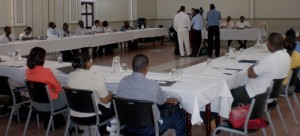- January 16, 2010
- Posted by: cdc
- Category: News

Several government and other stakeholder agencies are participating in a two-day workshop to prepare a draft disaster plan for government.
The Civil Defence Commission (CDC) is working to produce a draft plan on how to better tackle disaster situations and government may study the proposal for approval as early as Friday.
Yesterday, several key organizations listed as being critical players met at the Regency Suites in a two-day workshop to identify future actions in developing and implementing a National Damage Assessment and Needs Analysis (DANA).
CDC, the government’s disaster management agency is moving to design a readiness system that will allow emergency workers to report from troubled areas using their laptops and Blackberries.
CDC Director General, Colonel (Rtd), Chabilall Ramsarup, in opening the workshop yesterday, warned the participants that it is essential that the forum produce a workable plan that will meet approval from government since failure will mean going back to the drawing board.
Noting that the recent climate talks in Copenhagen, Denmark concluded there is an issue with global warming, the CDC boss warned that the country was under severe threat through rising sea levels and weather change.
“You are aware that our entire sea coast which has 80% of our population and 75% of the GDP (Gross Domestic Product) is under severe threat. We are experiencing severe weather conditions which have resulted in either extensive floods or drought, both of which affect our economic viability and also the psyche of our people.”
According to Ramsarup, the 2005-2006 floods have left Guyanese dissatisfied with the response. CDC, he said, is now moving to correct this issue by applying a more scientific method to determine the needs of people, not that all will be satisfied, but “we can at least make proper proposals to prioritize the most urgent need to save lives and reduce suffering and later address restoration of livelihoods and reconstruction.”
Tomorrow, participants of the workshop will be taken through the paces at the University of Guyana Computer Laboratory where they will receive training on how to report using Blackberries and Laptops.
The official disclosed that the CDC is implementing a series of programmes to improve its disaster management capacity at both the local and national level.
The ventures are being funded mainly by the United Nations Development Programme (UNDP) and the Inter-American Development Bank (IDB).
Some of the programmes include the establishment of DANA; the strengthening of an early warning system for floods and droughts; enhancement of emergency communication systems; improving search and rescue; minimal acceptable standards for emergency shelters, strengthening of relief supplies management capacity; development of mass casualty plans and national disaster risk management policy.
According to the Director General, the programmes also include the training of community leaders and mitigation of flood risks in pilot communities.
By December last year, the CDC, as part of its upgrade, completed the refurbishment of its National Emergency Operations Centre, conference room, a stand-by generator and a boat trailer.
The IDB has also funded a number of other important programmes, including the development of guidelines for training of technical staff of ministries in incorporating disaster risk reduction in agricultural planning and environmental management.
CDC also announced that it will be launching its website shortly on which the public will be able to access updates on disaster management and other important issues.
Meanwhile, Didier Trebucq, the United Nations Development Programme’s Deputy Resident Representative, noted that that entity has been working for over a year to reduce the risks of natural disasters.
“This four-year project is aimed at strengthening the country’s capacity to reduce disaster risks and is a joint initiative of the Government of Guyana, Inter-American Development Bank, and UNDP; it is worth over US$2M and will continue until the end of 2012.”
He also warned that the modern world is facing imminent threat from disasters and it is affecting sustainable development.
“During the period from June 2008 to June 2009, 343 disasters linked to natural hazards affected more than 42 million people, taking more than 14,000 lives and causing economic damage totaling US$57.4 billion.”
The UN official pointed out that floods, droughts, storms, earthquakes, fires and other events, when combined with risk drivers such as increasing urbanization, poor urban governance, vulnerable rural livelihoods and the decline of ecosystems, can lead to massive human misery and crippling economic losses.

“Although for some of us the statistics on disasters may seem to be an abstract set of figures, disasters are always a bitter reality. Guyana experienced that in 2005, when the January floods affected one-third of the country’s population and caused losses equivalent to 60% of GDP for that year.”
Sea level rise in the Caribbean is of such concern that it calls for immediate action, Trebucq said.
It is against this background that the workshop is appropriate, he noted, as it will be addressing an essential component of effective disaster management – the assessment of damage caused by disasters and analysis of the needs of the affected people.
Trebucq lauded the application of modern technology by CDC to launch its web-based disaster management platform- a WEB National Emergency Operations Centre.
The workshop’s participants were drawn from over 20 organizations, including the likes of the Red Cross Society, Relief Council, GPL, GT&T, NDIA, Ministry of Public Works and Lands and Survey CommisSource: sion.
Source: Kaieteur News
